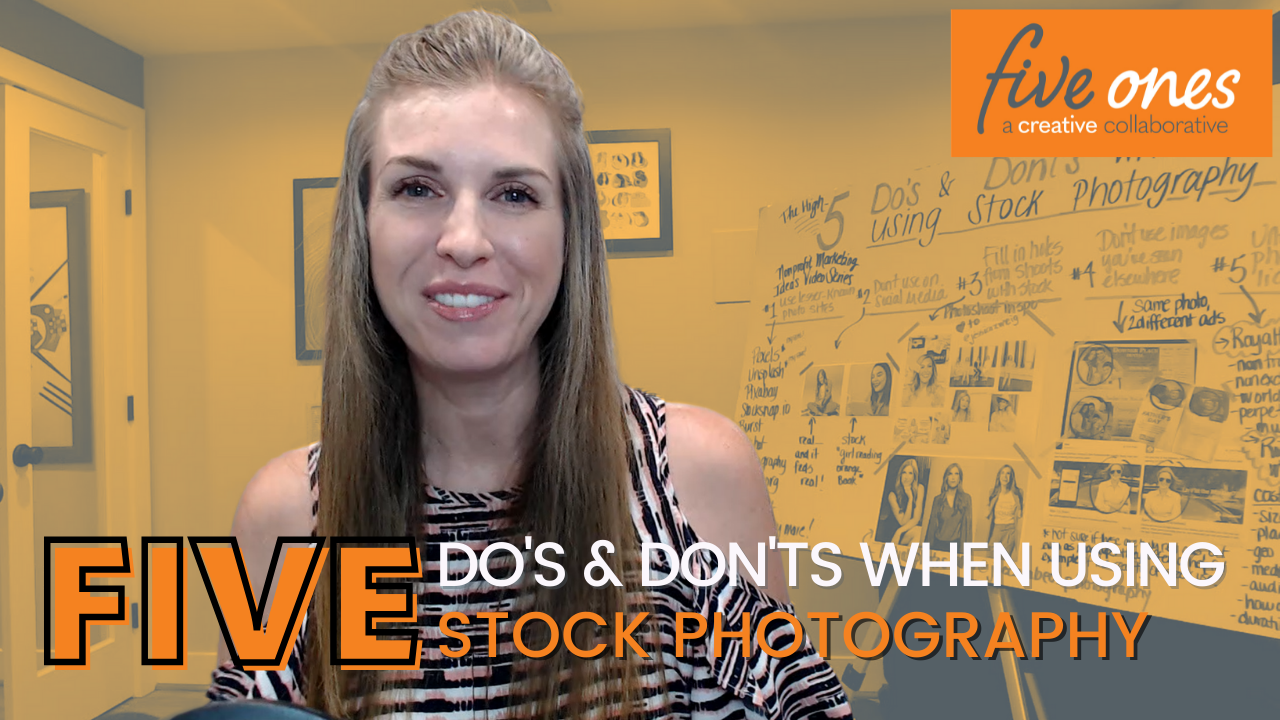
Five Do’s and Don’ts When Using Stock Photography
“A picture is worth a thousand words.” It’s not one of the most quotable phrases for nothing. It’s because it’s true; especially these days. In our pixilated world, we spend 50-75% of our day consuming media. At some point, we go into overload mode, stop reading and just look at pictures. It reminds me of library visits in elementary school. While free to roam, we’d flip through encyclopedias (yes, the big hefty books with slick pages and gold-leafed edges) that had millions of words. But it was much more fun to flip through and look at the pictures; there were just too many letters on the pages!
In the marketers’ realm, photos have the ability to help your brand rise to the top or, at its worst, make your brand simply look unattractive.
Here are some simple rules to provide your creative team (or if you’re in an agency, a production manager) when setting up a photo shoot.
1. Depth of field. Pick a viewpoint and make sure there are objects in the background and the foreground. This will give the photo depth – 2-D vs 1-D.
2. Lighting. The last thing you want to do is take a picture of the sky when it’s overcast and gray. Your photo will have “dead” space. Outdoor fashion spreads are shot at the crack of dawn because the light is coming in from the bottom and illuminating structure (cheekbones, etc) and not beating down causing shadows. If you’re taking photos inside, don’t just turn on all the lights. Instead, the light needs to be strategically placed so that it is highlighting the subject you want your audience to focus on.
3. Subjects. A photo of a swimming pool during the summer with no people is rather dull. It doesn’t represent what the pool is used for – swimming and having fun. Yes, it takes money to hire talent if you don’t want to collect photo releases from every person you take a photo of, but it’s well worth it. Action shots invite the viewer in while shots of inanimate objects aren’t that interesting.
4. Balance. If you want to take a picture of a building, don’t just stand in a position where you can fit the entire building the frame. Your photo will have no detail. Your viewer’s eye wants to focus on something and a photo from 100 feet away will not be interesting enough. Choose an angle and focus on part of the building that makes a statement – maybe it’s the entrance with a tall stone column or an interesting geometric walkway leading up to the front door. Or maybe it’s an American flag waving right in front of the name on the building.
So, what is a blog post about photography doing without any photography? Check out my High-Five video below that offers five tips when using stock photography because original photos aren’t an option.
Video Transcript:
Hi! Welcome to the latest episode of The High-Five Nonprofit Marketing Ideas. I’m Julia McDowell, Marketing Strategist for Five Ones. The High-Five is my video series of marketing strategies and tactics for nonprofits and associations, and today I’m talking about stock photography and how to use it on your website and beyond.
“A picture is worth a thousand words.” It’s not one of the most quotable phrases for nothing. It’s because it’s true; especially these days. In our pixilated world, we spend 50-75% of our day consuming media. At some point, we go into overload-mode, stop reading and just look at pictures. It reminds me of library visits in elementary school. While free to roam, we’d flip through encyclopedias (yes, the big hefty books with slick pages and gold-leafed edges) that had millions of words. But it was much more fun to flip through and look at the pictures; there were just too many letters on the pages!
In the marketers’ realm, photos have the ability to help your brand rise to the top or, at its worst, make your brand simply look unattractive.
Whether you’re creating a website, landing page, email newsletter, or social media post there is always a spot for an image. Probably because Tweets with images receive 35% more retweets, Facebook posts with a photo see a 37% increase in engagement, and in general, posts with images have 2.3 times more engagement. Basically, people like images to accompany the text. It draws them in and then you can hit them with the copy or call to action.
But, custom photography is expensive—it’s not always feasible or practical to hire a photographer to create an image for one Tweet or one email. This is where stock photography can come in handy. If you’re not familiar, stock photography is a bank of photos that users can access, typically for a fee, with different usage rights attached to them. Sites like Shutterstock, iStock, and Getty are good examples.
Here are 5 do’s and don’t when it comes to using stock photography for your nonprofit or association.
Do use lesser-known stock photography sites
While I mentioned the big names of stock photography, those are not the only stock photography websites out there. To find less-used, more authentic images (and to support smaller photographers!) search sites like Unsplash, Pexels, Pixabay, Stockvault, PikWizardfirst. Better yet? All of the images there are free and are able to be used anywhere, but make sure you give attribution.
Don’t use them on social media
Let’s go ahead and add advertising to this list, too. Using stock imagery for social media and ads isn’t the best idea. For both social media posts and ads, the image is usually the star of the show. It’s the thing that people see first, that they (for better or worse) judge you on right away. So, in those situations avoid using your classic stock photos. Instead, embrace the trend of posting raw, unfiltered images instead of the posed ones you’ll see on many stock websites. However, if you are in a bind and need to use stock, I highly recommend going to the lesser-known sites I mentioned in #1.
Do fill in holes from custom shoots with stock images
At some point or another, invest in a custom photography shoot. This could be tied to an event or a campaign, or when you have free time and extra budget. Make the most of this time with a photographer and capture images that are versatile, evergreen, and unique to your nonprofit or association. Before hiring a photographer, peruse stock photography sites to see what’s available and what you think you could use. Then, be sure to have the photographer you hire avoid taking similar shots. That way, you can use stock photos to fill in those holes and maximize the photographer’s time.
Don’t use images you’ve seen elsewhere
We all know these images. They’re the ones you’ve seen time and time again on click-bait stories, Facebook ads, the list goes on. While searching stock image sites, you’re bound to come across the same photo or one from the same shoot. STEER CLEAR. You don’t want someone visiting your site or social media and wondering where they’ve seen that very posed person before. If in doubt, do an image Google search to see what pops up.
Do understand the photo’s license
There are many different types of image licenses. The broadest is a free-use license which is exactly what it sounds like—you can use the image however you want. Then, there are licenses for editorial use, commercial use, promotional use, and more. These licenses are more nuanced, but their names are pretty self-explanatory. Some licenses are also only for one-time use. It’s important to read up on the licenses the photo you’d like to download and use has so you can use it correctly and avoid any issues. And just a note when you’re using your OWN photography to get a release and ensure you are aware of the places where you may use it and when permission runs out, if ever.
Thanks for joining me for today’s High-Five Nonprofit Marketing Ideas! I hope you learned a little more about how to use photos effectively. And remember, don’t be afraid to get in front of the camera yourself! Donors love putting faces to names.
Have a stock photography question for your nonprofit? Email me at julia@fiveones.com.



